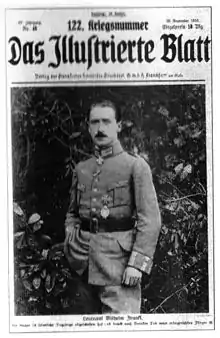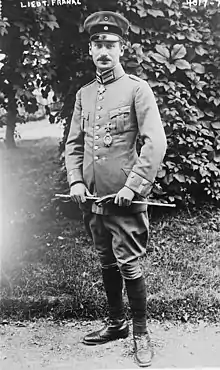Wilhelm Frankl
Wilhelm Frankl (20 December 1893 – 8 April 1917), Pour le Mérite, Royal House Order of Hohenzollern, Iron Cross, was a World War I fighter ace credited with 20 aerial victories.[1]

Wilhelm Frankl | |
|---|---|
 Frankl in 1916 | |
| Born | 20 December 1893 Hamburg, Germany |
| Died | 8 April 1917 (aged 23) Vitry-Sailly, France |
| Berlin-Charlottenburg | |
| Allegiance | German Empire |
| Service/ | Luftstreitkräfte |
| Years of service | 1914–1917 |
| Rank | Leutnant |
| Unit | Feldflieger Abteilung 40; Kampfeinsitzerkommando Vaux; Jagdstaffel 4 |
| Commands held | Jagdstaffel 4 |
| Awards | Pour le Mérite; Iron Cross; Royal House Order of Hohenzollern |
Personal life
Frankl was born the son of a Jewish businessman in Hamburg on 20 December 1893.[2] He later moved to Frankfurt am Main, and then to Berlin.[3] After he graduated from school, he pursued an interest in flying by attending Germany's hotbed of prewar aviation at Johannisthal. His instructor was Germany's first female pilot, Melli Beese. On 20 July 1913, Frankl earned pilot's license number 49.[3][4]
The outbreak of World War I sparked Frankl's volunteering to fly for his country. His flying ability and his personality both commended him to his superiors. While his professional life took off, so did his personal life. He fell in love with the daughter of Austrian Naval Kapitän zur See Edmund Stroll. Frankl converted to Christianity and married his love in early 1917.[4]
Aerial victories
Frankl began his career of aerial victories early in the war, before the concept of the synchronized machine gun firing safely through the plane's propeller became a practical reality.[5] On 10 May 1915, while flying as an observer in Feldflieger Abteilung 40 (FFA 40), he used a carbine to shoot down a French Voisin.[6] He was awarded an Iron Cross First Class for this feat.[2]
It took exactly eight months for his second triumph. On 10 January 1916, while flying a Fokker Eindecker with KEK Vaux, he downed another Voisin; this one was armed with a 37mm Hotchkiss cannon.[3] By 1 February, his victory total stood at four. Three months later, on 4 May, he became an ace. On 16 May, he was promoted from Vizefeldwebel into the officer's ranks as a Leutnant. He scored once more on 21 May. He was awarded the Knight's Cross with Swords of the Royal House Order of Hohenzollern during late May, followed by the Hanseatic Cross.[2] By this time, Frankl was one of only eight aces in the German flying service.[7] Frankl's gallantry earned him the Pour le Mérite after his eighth confirmed victory; the Blue Max was awarded on 16 July 1916.[2]
His guns rested until 2 August, when he tallied a Morane-Saulnier L. A double victory followed on 10 August. On 1 September 1916, he then transferred to Prussian Jagdstaffel 4 (Jasta 4) as it was formed from KEK Vaux, to fly Halberstadt D.Vs.[1][8] On 1 January 1917, he succeeded to command of the squadron.[2]
Four wins in September and two in October made him a triple ace. In late December 1916, Frankl succeeded to command of Jasta 4. Then, after a six-month hiatus, he scored a quadruple victory on 6 April 1917, and his twentieth win on the following day.[2]
Killed in action
His end came the day after that. While battling Bristol F.2 Fighters of No. 48 Squadron RFC on Easter Sunday, 8 April 1917,[9] Frankl's Albatros D.III lost its lower wing under the stress of combat manoeuvres, and he and his collapsed craft fell 800 m (2,600 ft) to his death near Vitry-Sailly, France.[1][10] Wilhelm Frankl was buried in Berlin-Charlottenburg.[2]
His legacy
Frankl's Jewish heritage likely resulted in his name and exploits being omitted from the 1938 book by Walter Zuerl, Pour le mérite-Flieger - Heldentaten und Erlebnisse unserer Kriegsflieger (Pour le mérite-Fliers - Heroic Deeds and Experiences of our Wartime Fliers),[11] an account of World War I fliers who won the Blue Max. After the end of World War II, Frankl's name was restored to the roll of German aces.
On 22 November 1973, the Luftwaffe named the air force barracks in Neuburg an der Donau after Wilhelm Frankl.[12] The "Wilhelm-Frankl-Kaserne"[13] is home to the Luftwaffe's Fighter Wing 74.[14]
References
- "Wilhelm Frankl". Retrieved 29 April 2017.
- Franks et al 1993, pp. 108–109.
- Early German Aces of World War I. p. 31.
- "Orden Pour le Mérite". Retrieved 29 April 2017.
- "Synchronizing Gear". Retrieved 29 April 2017.
- Early German Aces of World War I. p. 31.
- Early German Aces of World War I. p. 56.
- "Jasta 4". Retrieved 29 April 2017.
- Frequency of Occurrences of the Date of Easter 1875 to 2124
- Albatros Aces of World War I. p. 20.
- Bronnenkant, Lance J. The Blue Max Airmen: German Airmen Awarded the Pour le Mérite, Vol.1, with illustrations by Jim Miller (Indio, CA: Aeronaut Books, 2012)
- de:Wilhelm Frankl
- "Google Maps". Retrieved 29 April 2017.
- de:Jagdgeschwader 74
Bibliography
- Norman Franks, Frank W. Bailey, Russell Guest. Above the Lines: The Aces and Fighter Units of the German Air Service, Naval Air Service and Flanders Marine Corps, 1914–1918. Grub Street, 1993. ISBN 0-948817-73-9, ISBN 978-0-948817-73-1.
- Greg VanWyngarden (2007-06-19). Albatros Aces of World War 1. Osprey Pub Co. ISBN 978-1-84603-179-3.
- Greg VanWyngarden; Harry Dempsey (2006-10-31). Early German Aces of World War I. Osprey Pub Co. ISBN 978-1-84176-997-4.